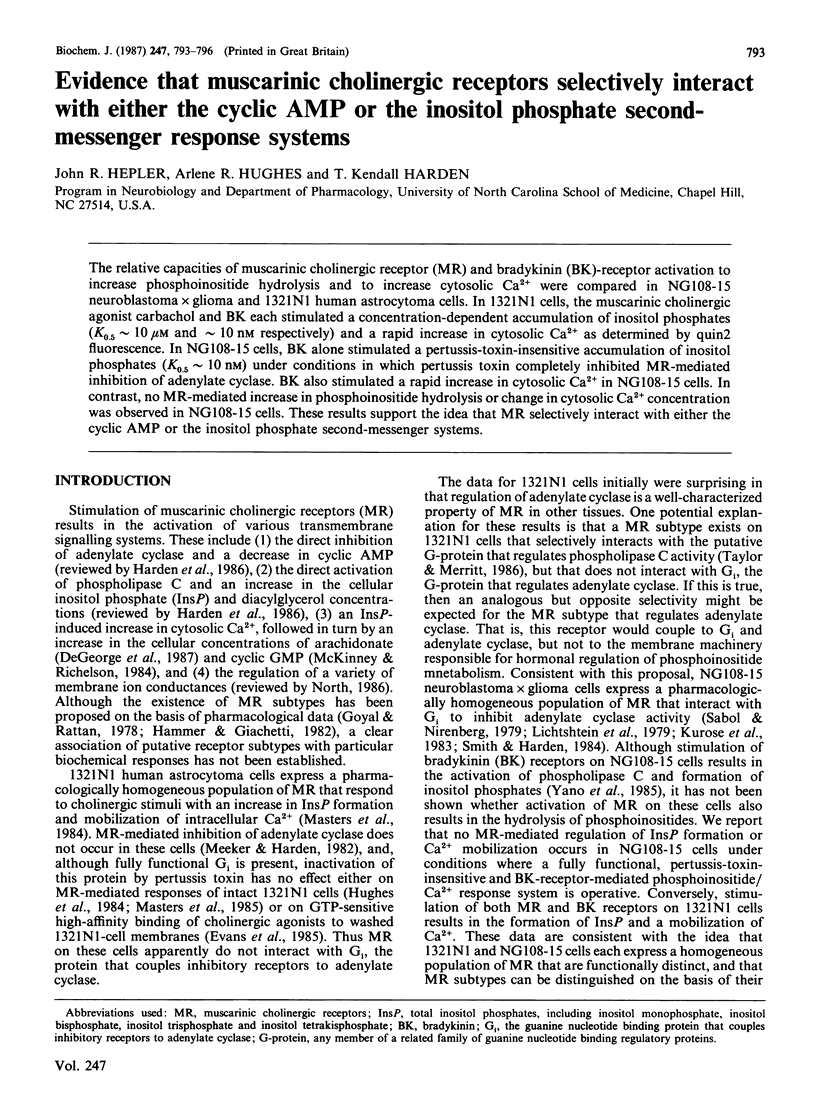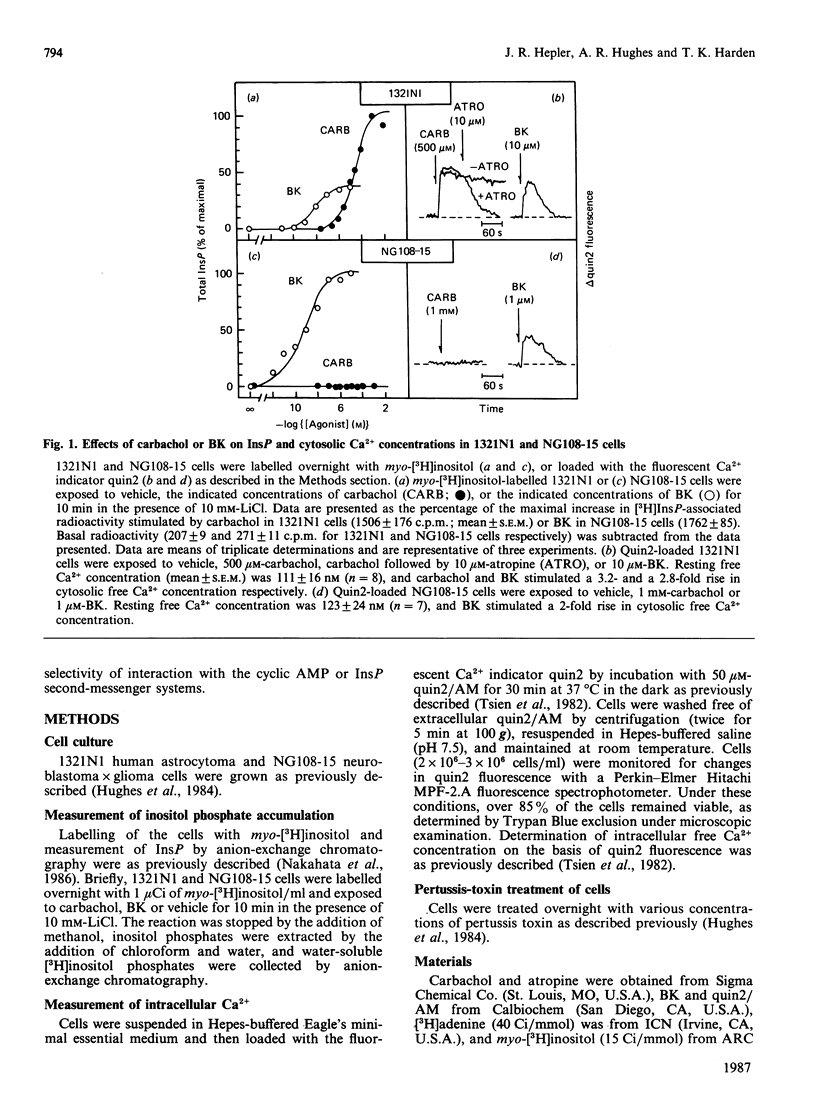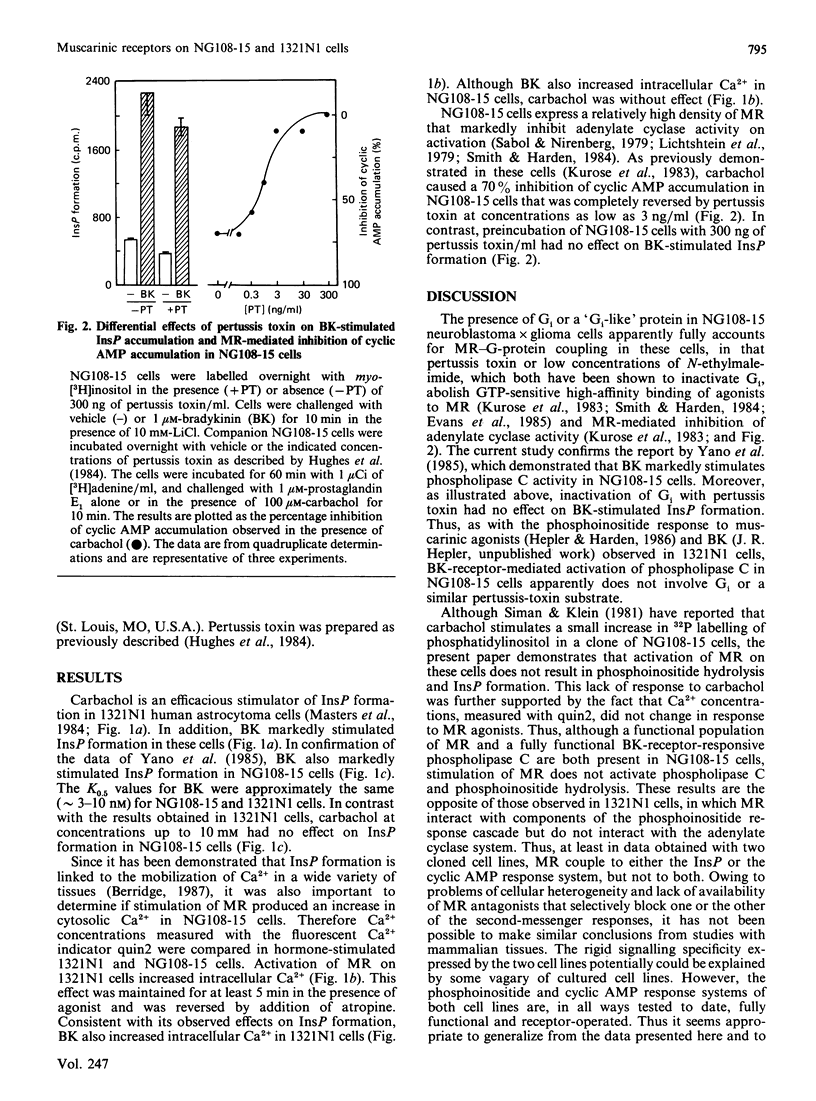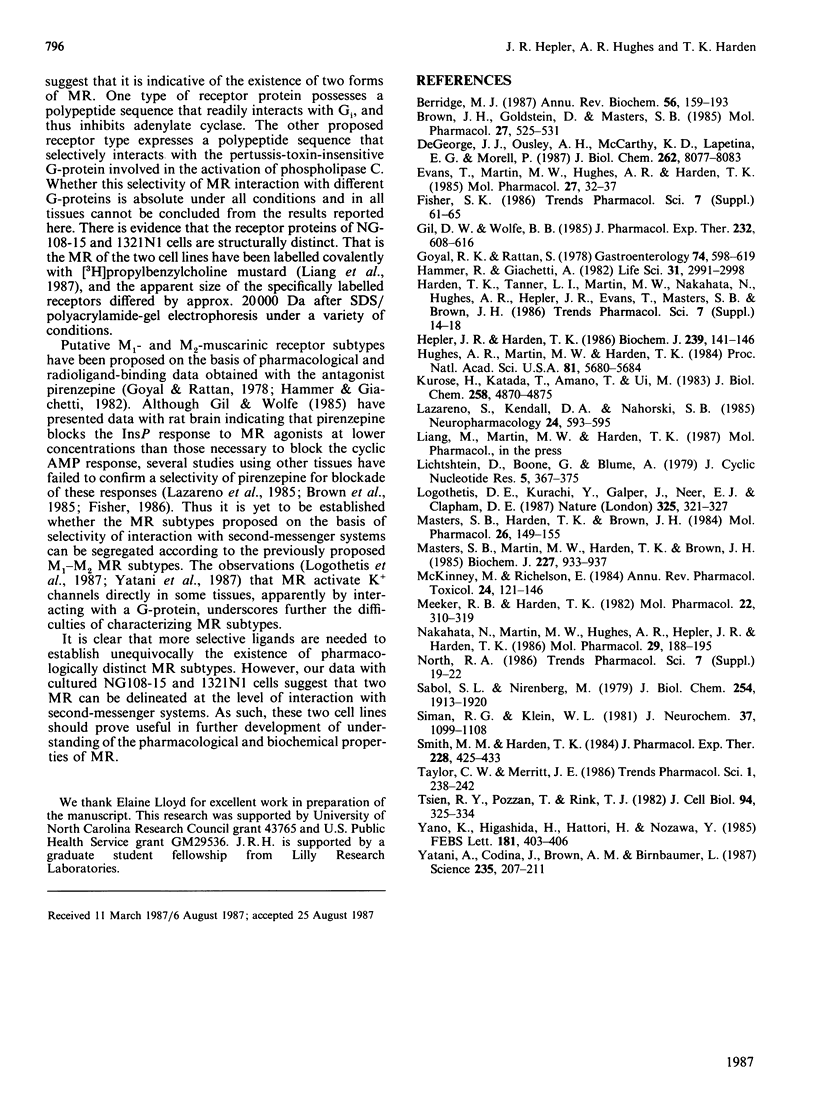Abstract
The relative capacities of muscarinic cholinergic receptor (MR) and bradykinin (BK)-receptor activation to increase phosphoinositide hydrolysis and to increase cytosolic Ca2+ were compared in NG108-15 neuroblastoma x glioma and 1321N1 human astrocytoma cells. In 1321N1 cells, the muscarinic cholinergic agonist carbachol and BK each stimulated a concentration-dependent accumulation of inositol phosphates (K0.5 approximately 10 microM and approximately 10 nM respectively) and a rapid increase in cytosolic Ca2+ as determined by quin2 fluorescence. In NG108-15 cells, BK alone stimulated a pertussis-toxin-insensitive accumulation of inositol phosphates (K0.5 approximately 10 nM) under conditions in which pertussis toxin completely inhibited MR-mediated inhibition of adenylate cyclase. BK also stimulated a rapid increase in cytosolic Ca2+ in NG108-15 cells. In contrast, no MR-mediated increase in phosphoinositide hydrolysis or change in cytosolic Ca2+ concentration was observed in NG108-15 cells. These results support the idea that MR selectively interact with either the cyclic AMP or the inositol phosphate second-messenger systems.
Full text
PDF



Selected References
These references are in PubMed. This may not be the complete list of references from this article.
- Berridge M. J. Inositol trisphosphate and diacylglycerol: two interacting second messengers. Annu Rev Biochem. 1987;56:159–193. doi: 10.1146/annurev.bi.56.070187.001111. [DOI] [PubMed] [Google Scholar]
- Brown J. H., Goldstein D., Masters S. B. The putative M1 muscarinic receptor does not regulate phosphoinositide hydrolysis. Studies with pirenzepine and McN-A343 in chick heart and astrocytoma cells. Mol Pharmacol. 1985 May;27(5):525–531. [PubMed] [Google Scholar]
- DeGeorge J. J., Ousley A. H., McCarthy K. D., Lapetina E. G., Morell P. Acetylcholine stimulates selective liberation and re-esterification of arachidonate and accumulation of inositol phosphates and glycerophosphoinositol in C62B glioma cells. J Biol Chem. 1987 Jun 15;262(17):8077–8083. [PubMed] [Google Scholar]
- Evans T., Martin M. W., Hughes A. R., Harden T. K. Guanine nucleotide-sensitive, high affinity binding of carbachol to muscarinic cholinergic receptors of 1321N1 astrocytoma cells is insensitive to pertussis toxin. Mol Pharmacol. 1985 Jan;27(1):32–37. [PubMed] [Google Scholar]
- Gil D. W., Wolfe B. B. Pirenzepine distinguishes between muscarinic receptor-mediated phosphoinositide breakdown and inhibition of adenylate cyclase. J Pharmacol Exp Ther. 1985 Mar;232(3):608–616. [PubMed] [Google Scholar]
- Goyal R. K., Rattan S. Neurohumoral, hormonal, and drug receptors for the lower esophageal sphincter. Gastroenterology. 1978 Mar;74(3):598–619. [PubMed] [Google Scholar]
- Hammer R., Giachetti A. Muscarinic receptor subtypes: M1 and M2 biochemical and functional characterization. Life Sci. 1982 Dec 27;31(26):2991–2998. doi: 10.1016/0024-3205(82)90066-2. [DOI] [PubMed] [Google Scholar]
- Hepler J. R., Harden T. K. Guanine nucleotide-dependent pertussis-toxin-insensitive stimulation of inositol phosphate formation by carbachol in a membrane preparation from human astrocytoma cells. Biochem J. 1986 Oct 1;239(1):141–146. doi: 10.1042/bj2390141. [DOI] [PMC free article] [PubMed] [Google Scholar]
- Hughes A. R., Martin M. W., Harden T. K. Pertussis toxin differentiates between two mechanisms of attenuation of cyclic AMP accumulation by muscarinic cholinergic receptors. Proc Natl Acad Sci U S A. 1984 Sep;81(18):5680–5684. doi: 10.1073/pnas.81.18.5680. [DOI] [PMC free article] [PubMed] [Google Scholar]
- Kurose H., Katada T., Amano T., Ui M. Specific uncoupling by islet-activating protein, pertussis toxin, of negative signal transduction via alpha-adrenergic, cholinergic, and opiate receptors in neuroblastoma x glioma hybrid cells. J Biol Chem. 1983 Apr 25;258(8):4870–4875. [PubMed] [Google Scholar]
- Lazareno S., Kendall D. A., Nahorski S. R. Pirenzepine indicates heterogeneity of muscarinic receptors linked to cerebral inositol phospholipid metabolism. Neuropharmacology. 1985 Jun;24(6):593–595. doi: 10.1016/0028-3908(85)90071-1. [DOI] [PubMed] [Google Scholar]
- Lichtshtein D., Boone G., Blume A. Muscarinic receptor regulation of NG108-15 adenylate cyclase: requirement for Na+ and GTP. J Cyclic Nucleotide Res. 1979 Oct;5(5):367–375. [PubMed] [Google Scholar]
- Logothetis D. E., Kurachi Y., Galper J., Neer E. J., Clapham D. E. The beta gamma subunits of GTP-binding proteins activate the muscarinic K+ channel in heart. Nature. 1987 Jan 22;325(6102):321–326. doi: 10.1038/325321a0. [DOI] [PubMed] [Google Scholar]
- Masters S. B., Harden T. K., Brown J. H. Relationships between phosphoinositide and calcium responses to muscarinic agonists in astrocytoma cells. Mol Pharmacol. 1984 Sep;26(2):149–155. [PubMed] [Google Scholar]
- Masters S. B., Martin M. W., Harden T. K., Brown J. H. Pertussis toxin does not inhibit muscarinic-receptor-mediated phosphoinositide hydrolysis or calcium mobilization. Biochem J. 1985 May 1;227(3):933–937. doi: 10.1042/bj2270933. [DOI] [PMC free article] [PubMed] [Google Scholar]
- McKinney M., Richelson E. The coupling of the neuronal muscarinic receptor to responses. Annu Rev Pharmacol Toxicol. 1984;24:121–146. doi: 10.1146/annurev.pa.24.040184.001005. [DOI] [PubMed] [Google Scholar]
- Meeker R. B., Harden T. K. Muscarinic cholinergic receptor-mediated activation of phosphodiesterase. Mol Pharmacol. 1982 Sep;22(2):310–319. [PubMed] [Google Scholar]
- Nakahata N., Martin M. W., Hughes A. R., Hepler J. R., Harden T. K. H1-histamine receptors on human astrocytoma cells. Mol Pharmacol. 1986 Feb;29(2):188–195. [PubMed] [Google Scholar]
- Sabol S. L., Nirenberg M. Regulation of adenylate cyclase of neuroblastoma x glioma hybrid cells by alpha-adrenergic receptors. I. Inhibition of adenylate cyclase mediated by alpha receptors. J Biol Chem. 1979 Mar 25;254(6):1913–1920. [PubMed] [Google Scholar]
- Siman R. G., Klein W. L. Specificity of muscarinic acetylcholine receptor regulation by receptor activity. J Neurochem. 1981 Nov;37(5):1099–1108. doi: 10.1111/j.1471-4159.1981.tb04659.x. [DOI] [PubMed] [Google Scholar]
- Smith M. M., Harden T. K. Modification of receptor-mediated inhibition of adenylate cyclase in NG108-15 neuroblastoma X glioma cells by n-ethylmaleimide. J Pharmacol Exp Ther. 1984 Feb;228(2):425–433. [PubMed] [Google Scholar]
- Tsien R. Y., Pozzan T., Rink T. J. Calcium homeostasis in intact lymphocytes: cytoplasmic free calcium monitored with a new, intracellularly trapped fluorescent indicator. J Cell Biol. 1982 Aug;94(2):325–334. doi: 10.1083/jcb.94.2.325. [DOI] [PMC free article] [PubMed] [Google Scholar]
- Yano K., Higashida H., Hattori H., Nozawa Y. Bradykinin-induced transient accumulation of inositol trisphosphate in neuron-like cell line NG108-15 cells. FEBS Lett. 1985 Feb 25;181(2):403–406. doi: 10.1016/0014-5793(85)80301-x. [DOI] [PubMed] [Google Scholar]
- Yatani A., Codina J., Brown A. M., Birnbaumer L. Direct activation of mammalian atrial muscarinic potassium channels by GTP regulatory protein Gk. Science. 1987 Jan 9;235(4785):207–211. doi: 10.1126/science.2432660. [DOI] [PubMed] [Google Scholar]


